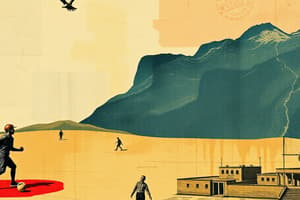Podcast
Questions and Answers
According to the content, what is the primary goal of recreation and animation in tourism?
According to the content, what is the primary goal of recreation and animation in tourism?
- To create a positive and lasting environment for tourists (correct)
- To provide entertainment for tourists
- To increase the company’s economy
- To promote social life and culture within a tourist establishment
What are the two main objectives of sport tourism, as defined in the content?
What are the two main objectives of sport tourism, as defined in the content?
- To provide entertainment and relaxation for tourists
- To increase the company’s economy and promote social life within a tourist establishment
- To develop communication and promote social life within a tourist establishment
- To energize the company’s economy and accompany the user/tourist (correct)
What is the key issue in managing recreation resources within the tourism industry?
What is the key issue in managing recreation resources within the tourism industry?
- The seasonality of the market (correct)
- The high demand
- The capacity of the service
- The low demand
To manage demand greater than supply (D > S), two possible actions are discussed. Which are they?
To manage demand greater than supply (D > S), two possible actions are discussed. Which are they?
Which of the following is NOT a characteristic of tourism, as defined in the content?
Which of the following is NOT a characteristic of tourism, as defined in the content?
Flashcards
What is Tourism?
What is Tourism?
Activities that people do during their travel to destinations outside of their usual residence, lasting less than a year, for purposes like leisure, business, or other reasons.
What is recreation in tourism?
What is recreation in tourism?
The activities organized by one or more individuals for a group of people, focusing on promoting social interactions, cultural experiences, and a positive environment within a tourist facility.
What other objective does recreation in tourism have?
What other objective does recreation in tourism have?
The activities organized by one or more individuals for a group of people, aimed at increasing financial activity and promoting the economy of the company.
What is seasonality in recreation tourism?
What is seasonality in recreation tourism?
Signup and view all the flashcards
How can you manage seasonality in recreation tourism?
How can you manage seasonality in recreation tourism?
Signup and view all the flashcards
Study Notes
Tourism
- Tourism is defined as activities people undertake during travels and stays in places other than their usual environment, for a period less than one year, typically for leisure, business, or other reasons.
Sports Tourism
- Sports tourism involves actions by individuals or groups, aiming to improve communication and cultural experiences within a tourist establishment to foster a lasting environment.
- Another stated objective is to energize and promote a company's economy by accompanying the tourist to enjoy free time.
Touristic Animation Aims
- Building customer loyalty
- Increasing customer permanence
- Developing an affective and positive climate for customers
- Maintaining a strong brand
- Creating seasonal attractions
Characteristics of Recreational Services
- Intangibility: Sensitive to demand, easily imitated, difficult to fix a price; quality is determined by the customer after consumption.
- Heterogeneity: Variable nature of services in the market; avoiding repetition of a service to maintain interest.
- Development: Simultaneous production and consumption of services; the consumer is present throughout the process; decentralization of service provision.
- Expiration: Services are perishable and cannot be stored, leading to supply and demand adjustments.
Possible Solutions to Service Limits
- Intangibility: Make the service visible and tangible; associate it with tangible products; differentiate the product and its quality; employ personalized promotional media and create a brand.
- Heterogeneity: Industrialize the service and implement quality control strategies.
- Development: Involve consumers in the production process; centralize production; reduce difficulties with massive production; study the consumer; implement diverse sales points; offer training for employees.
- Expiration: Ensure that services are readily available where they are needed; adapt supply to fluctuating demand.
Types of Tourist Animation Programs
- Simple: A single program addressing the needs of all users. Activities should ideally be offered daily in catering to varying ages.
- Parallel: Multiple parallel programs catering to specific user needs (e.g., skill levels, age groups).
Classification of Activities Based on Consumers
- Hedonists: Focus on sports activities such as nautical sports (sailing, windsurfing, kitesurfing), racket sports, open-air activities (archery, orienteering), and adventure sports (kayaking, climbing).
- Routinary: Activities centered around the family, such as alternative sports, team-building activities, and activities for children. They prefer familiarity and comfort zones.
- Passive: Relaxation-focused activities such as Tai chi, dancing, yoga, and general physical activity for health. They want relaxation.
- Workaholics: Participants engage in cultural/recreational activities like guided tours, evening entertainment, shows, competitions, card games, and gambling— activities to remain engaged.
Hotel Animation Program Characteristics
- Should be recreational in nature and creative.
- Animation should be an essential resource.
- Pace and activities must be balanced, catering to diverse client needs.
- Activities must be varied and appropriate to target clientele.
- Animation should be spread throughout the day to hold customer interest.
- Should be engaging without being mandatory.
Studying That Suits You
Use AI to generate personalized quizzes and flashcards to suit your learning preferences.




